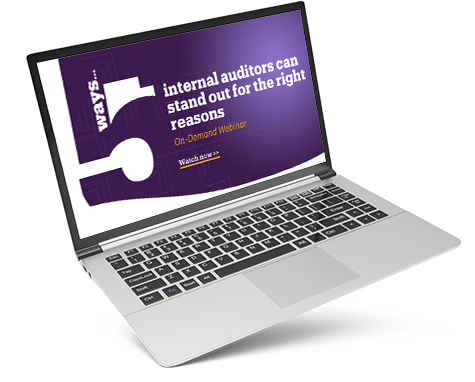Many internal auditors are frustrated with the limited role that their team plays within their organization. They’re often brought in to identify problems after they’ve occurred, when early warnings might have mitigated the risk early on. And even when the audit team does provide warnings, they’re often ignored by the business units.
A strong internal controls process is required for compliance with the Sarbanes-Oxley Act (SOX) or other regulatory standards, so organizations look to their audit team primarily to meet compliance objectives and to check boxes. But when armed with the right data and the right connections within the organization, audit has the potential to drive much greater value—to serve as a true strategic partner of the business.
In order to get to that elevated level, the internal audit function needs to generate executive buy-in for their work. Here are some strategies for engaging the right stakeholders in your process, incorporating insights from internal auditors who participated in a roundtable with the Institute of Internal Auditors (IIA).
- Identify the right stakeholders
To gain visibility for the role of audit, the employees you engage with in your auditing work are not necessarily the same people that you need to talk to for visibility. In order to reach the right stakeholders, it’s important to build a strategy around engaging with managers who fall outside your day-to-day operations, and to record which managers you’ve connected with and what progress has been made.
“A clear visual map, showing who we need to speak to, can really help focus efforts. In addition to our assurance stakeholder plan, which looks at who we need to know to perform our audits in the year ahead, we have a separate governance stakeholder plan that targets who we need to know at a higher level so we can raise our profile.” - Showcase your expertise through ongoing communications
In order to prove value to the executive suite, look for opportunities to offer insights on current issues such as new regulations and external risk factors, as well as general insights on the auditing process. For instance, consider hosting quarterly webinars for managers through all of the business units, or publishing a monthly e-newsletter that showcases your senior auditors’ opinions on relevant topics and their potential impact on your organization. Whatever method you choose, focus on demonstrating your team’s subject matter expertise, and be sure to facilitate open discussion.
“We’ve issued memos to the whole business about risks and problems we’ve found, which has really helped,” said one internal auditor. “We’ve made it clear that this is not about blaming one regional office, but about highlighting common and important issues to help everyone improve.” - Streamline your processes
A key reason internal audit isn’t always able to add value to the business is because the unit lacks visibility into overall business trends. In other words, if you’re only looking at a few trees, you might not notice the start of a forest fire. In order to be able to notice key risk factors in the business, it’s important to incorporate technology that the entire 3LoD will use, with transparent access to data across the board. By consolidating data in one central dashboard and ensuring that all teams are using the same criteria for measurement, the internal audit team can gain access to the insights it needs to drive influence throughout the organization. - Take full inventory of your risks
Rather than focusing only on compliance-related metrics, collaborate with the rest of the 3LoD to list all of your organization’s potential risks, and then build a framework for mitigating and managing them, with identified managers taking ownership of each risk. “We can spark conversations and raise issues about risks in ways that senior management may not have thought of, which might lead to a new perception of risk,” said one participant in the roundtable. “A good example is around long-term risks such as climate change.” - Produce real-time data analysis
Rather than simply waiting for an annual or quarterly audit to produce audit results, your audit team should make use of an analytics solution with real-time data feeds to gather up-to-the-minute reports on your organization’s compliance status and risk analysis. A best-in-class solution will allow them to easily build multiple views with the right data to bring to board meetings and share with company leadership. That will help your team showcase evidence of trends and highlight early warning signs for risks that should be actioned. - Align with stakeholders on auditing strategy
As your executive team plans the year ahead and provides you with their requested audits, focus on getting time with them to work through exactly what will be measured and how it will be measured. One roundtable participant said that they use their audit overviews “as a starting point for pre-planning discussions with stakeholders, which includes identifying what data they use to manage their area and the source of this data. This then forms the basis of designing our data analytics tests.”
Internal audit can be a powerful force in risk management and overall business strategy—but only if it has the right tools and data to help the audit team generate insights that will mitigate risk and drive the business forward. By adopting best-in-class artificial intelligence technology that can help you automate tasks and streamline data collection and analysis, you’ll be armed with the insights to help you provide true strategic guidance to your organization.
By showcasing your knowledge of new risks and data trends within the organization and in your industry, you’ll be able to win a position of influence for the internal audit team, leading to greater visibility and recognition throughout the organization.
On-demand webinar:
Dare to be different: 5 ways auditors can stand out for the right reasons
Dan Clark, a former CAE, shares five strategies to immediately benefit your team and organization—and increase your long-term value and career growth.
- Build alignment with stakeholders
- Evolve the 3LOD with new tools
- Deepen data analytics









